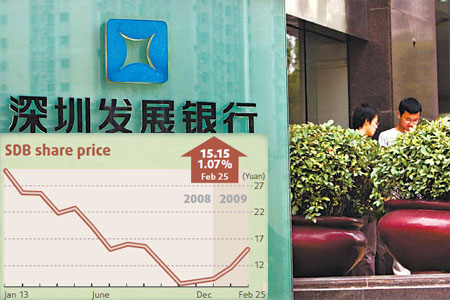
|
BIZCHINA> Industries
 |
|
Finance: SDB reduces bad loans
By Yang Zhen (China Daily)
Updated: 2009-02-26 07:53
 The Shenzhen Development Bank (SDB) has won applause from stock analysts and is endearing itself to investors after starting on a clean slate and writing off its entire non-performing and questionable loans.
The move improved the bank's asset quality substantially and helped regain market confidence. Despite the fall in earnings, "investors are still buying SDB shares as they do not have to contend with nasty surprises in future," said Feng Wei, analyst, Guohai Securities. SDB's shares surged on the Shenzhen Stock Exchange after it came out with its earnings numbers. The price surge was further helped by rumors that China Development Bank was contemplating a stake buy in SDB. The bank shares were subsequently suspended from trading on Feb 23 until rumors were denied by both the banks yesterday. SDB's shares, at their closing price of 15.15 yuan yesterday have surged nearly 60 percent since its earnings announcement on Jan 13. A spokesman from SDB said the lender has been focusing on asset quality management after a new management team took over following the entry of Newbridge Capital at the end of 2004. "Trade finance has been the focus of our business since 2005. Instead of lending long-term loans, we prefer short-term loans, of usually three to six months, for a specific project of the company. This way, we are able to monitor the project more closely and also ensure the quality of our assets. We have maintained a non-performing loan (NPL) ratio of 0.7 percent for the loans issued through trade finance," said an SDB spokesman. According to SDB's financial statement, before the write-offs trade finance accounted for 41.5 percent of the lender's total outstanding loans. Among SDB's 11.1 billion yuan non-performing loans before the write-offs, only 708 million yuan bad loans were incurred after Jan 1, 2005, the financial statement said. "SDB's profit in 2008 before the write-offs was 8.2 billion yuan. It means SDB experienced consistent growth in recent years. The 9.4 billion yuan bad loans SDB wrote off mostly came from bad decisions made before 2005," Feng said. But Feng also warned that the global financial crisis was slowly beginning to impact Chinese financial institutions. "It has been harder for Chinese lenders to make a profit following a series of interest rate reductions by the central bank. We also notice that non-performing loans are increasing among Chinese lenders," Feng said. According to SDB, before the write-offs, 34.2 percent of its outstanding corporate loans went to the manufacturing industry, which has been suffering due to dwindling demand from overseas markets. Shenzhen, the bank's home turf, is also facing problems due to falling exports, massive corporate failures and crashing property prices. Official figures showed that China's exports plummeted by 17.5 percent from a year earlier in January. Nearly 48 companies in Shenzhen had salary arrears of 30 million yuan, according to local media reports. Property prices in Shenzhen fell by 16.5 percent year-on-year, the most among major Chinese cities, in January. The Chinese banking regulator has tightened its control on domestic lenders' bad assets due to the global financial crisis. New regulations require Chinese lenders' coverage ratio, a bank's reserves for bad loans against its outstanding non-performing loans, to be higher than 130 percent. SDB's coverage ratio rose to 105 percent after the write-offs, from 54.6 percent as at the end of September 2008. The write-offs also trimmed SDB's NPL ratio from 4.3 percent at the end of September to less than 1 percent. (For more biz stories, please visit Industries)
|
|||||